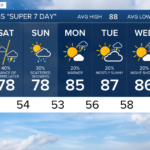BOZEMAN, Mont. (AP) — With control of the Senate potentially at stake, Donald Trump is visiting Montana on Friday hoping to address some unfinished business from 2018, when he campaigned repeatedly in Big Sky Country in a failed attempt to remove incumbent Democratic Sen. Jon Tester.
Tester has been trying to persuade voters that he’s aligned with Trump on many issues, following his successful strategy from six years ago. While this worked in a non-presidential election year, it faces a tougher test this fall with Tester’s opponent, former Navy SEAL Tim Sheehy, trying to associate the three-term incumbent with Democratic presidential candidate Kamala Harris.
Harris has garnered national support from key Democratic groups, who rallied around her quickly after President Joe Biden exited the campaign last month. She has attracted large crowds in swing states, touring this week with Minnesota Gov. Tim Walz, her chosen vice presidential nominee.
Meanwhile, Trump’s only rally this week will be in a state he won by 16 percentage points four years ago, rather than a battleground in November. Faced with new pressure in the race from a candidate with growing enthusiasm, Trump dismissed questions about his lack of visits to swing states as “stupid.”
“I don’t need to go there because I’m leading those states,” he stated. “I’m going because I want to support senators and congressmen in getting elected.”
He will also make fundraising stops in Wyoming and Colorado.
Trump’s Influence in Montana’s Senate Race
Friday’s rally at Montana State University, beginning at 8 p.m. Mountain time, is expected to attract thousands of GOP supporters. However, the former president’s major impact could be simply having his name above Sheehy’s on the ballot in November, according to University of Montana political analyst Rob Saldin.
“There is a segment of the electorate that will turn out when Trump is on the ticket,” Saldin said. And that could benefit Sheehy, a Trump supporter and political newcomer who made a fortune from an aerial firefighting business.
Republicans have dominated in Montana for over a decade and currently hold every statewide office except Tester’s.
Tester narrowly won each of his previous Senate races by positioning himself as a straightforward farmer who forms personal connections with Montanans and is willing to go against his party on important issues. He has also been successful in fundraising.
The race has gained national attention, with Democrats holding a slim majority in the Senate and defending more seats compared to the GOP this year. Tester is seen as one of the most vulnerable Democratic incumbents.
In order for him to win, a large number of Trump supporters would need to vote for a split ticket and support the Democratic senator.
Trump’s efforts to remove Tester stem from the lawmaker’s role in 2018 as chairman of the Senate Committee on Veterans’ Affairs. Tester exposed past misconduct by Trump’s personal doctor, Ronny Jackson, which led to Jackson’s nomination to lead the Department of Veterans Affairs being withdrawn.
As the sitting president, Trump came to Montana four times to campaign for Republican Matt Rosendale, who was the state auditor at the time. Rosendale lost by 3 percentage points.
Tester’s Distinction from National Democrats
Prior to Trump’s recent visit, Tester has worked to distance himself from the Democratic establishment by highlighting the Republicans who support him, including former Montana Gov. Marc Racicot. His campaign emphasized over 20 pieces of legislation, many related to veterans’ issues, that Tester sponsored and Trump signed.
Tester was the only Democratic delegate from Montana to refrain from voting for Harris as the party’s presidential candidate following Biden’s exit. When the Democratic National Convention takes place later this month in Chicago, Tester will be in Montana “farming and meeting face to face with Montanans,” according to campaign spokesperson Harry Childs.
The last time Tester attended the Democratic National Convention was in 2008, which is also the last time a Democratic presidential candidate came close to winning Montana, with President Barack Obama losing by slightly over 2 percentage points.
Friday’s rally will be held in Gallatin County, where Tester has relied on heavily throughout his political career.
He lost the county in his first Senate race in 2006, but his support has grown since then. A significant victory margin in Gallatin in 2018 helped him surpass Rosendale.
Republican Don Seifert, a former Gallatin County commissioner, voted for Tester in 2018 and plans to do so again this year.
Seifert supported Trump in 2016 and has continued to back other Republicans, including Montana Gov. Greg Gianforte and Sen. Steve Daines.
“Montanans tend to vote for the individual over the party,” Seifert commented. “For the state of Montana, Jon is the one who can deliver what we need.”
However, Sheehy claims that Tester has lost touch with Montana and has aligned himself with Democrats in Washington. The Republican accused Tester in a message to supporters this week of being “responsible for the rise of Kamala Harris” due to his role as chairman of the Democratic Senatorial Campaign Committee from 2015 to 2017 when she was elected to the Senate from California.
Tester has raised over three times the amount Sheehy has in campaign donations reported to the Federal Election Commission. Nevertheless, outside groups supporting Sheehy have helped narrow that gap, pouring millions of dollars into the race as advertisements from both sides saturate Montana’s airwaves.





